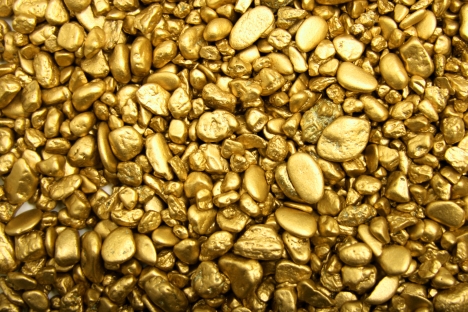A Russian gold rush in the works

Russia is the fourth-largest gold producer in the world, after China, Australia and the United States, but it ranks second in the world in terms of proven reserves. Source: Shutterlock / Legion Media
Last summer, a new addition was made to the world’s collection of unique gold ingots. A heart-shaped gold nugget weighing 2.4 pounds was found in Russia’s Irkutsk Region. Irkutsk, located in central Siberia, is the fifth-largest region in Russia and is the country’s second-largest gold-producing area. It is home to one-fifth of the country’s gold production facilities.
Were it not for the unique shape of the nugget, however, the find would hardly have made the headlines. The weight of the little heart is only a tiny fraction of the 250 tons of gold produced in Russia every year.
Russia is the fourth-largest gold producer in the world, after China, Australia and the United States, but it ranks second in the world in terms of proven reserves. Although the sector is highly fractured — more than 600 companies work in gold production in Russia — the industry has its major players. The country’s biggest producer is Polyus Gold, which is also one of the top 10 gold producers in the world.
According to the official statistics from Russia’s state statistics agency, Rosstat, in 2012 Russian companies increased year-on-year gold production by 8.3 percent. Polyus, for its part, increased the production of refined gold by 12 percent and is anticipating even better numbers for 2013 — in particular, the company has said it expects to produce 1.8 million ounces of gold in 2013, up from 1.68 million in 2012.
The lion’s share of Russia’s gold comes from the extraction of mineral resources, which was up 6.3 percent in 2012 to 200 tons. Gold also comes into circulation through the recycling of scrap and waste.
In the past year, nearly all of Russia’s gold-producing areas reported growth in production. Numbers were particularly strong in the Krasnoyarsk Territory and the Irkutsk, Magadan and Chelyabinsk Regions. There was a drop in output at the Kupol Deposit in the Chukotka Autonomous Region in the Far East, but the Prime news agency reported that the decrease was a result of a known reduction of gold content in processed ore there.
Gold production is likely to increase throughout 2013, which could result in Russia overtaking the United States as the third-largest gold producing country in the world by volume.
Commenting on the numbers, Investcafe analyst Andrei Schenck noted that the increase in production was due to more output from existing facilities rather than new ones coming online, and that Russia’s potential for gold production is far from exhausted. “Some projects have been implemented, while others are still in the development stage,” Schenck said.
In 2014, production is scheduled to begin at Russia’s largest gold deposit, Polyus Gold’s Natalka. Although Natalka was discovered during World War II, it sat idle for many years due to its remote location in the Magadan Region, in the northern corner of Russia’s Far East. Once production begins at the facility, Natalka will process 11 million tons of ore and produce 16.5–22 tons of gold per year.
A gold mine is also under construction at the neighboring Pavlik deposit. Another 7.3 tons of gold a year are expected to be produced at this site, which is under the management of the metals investment firm Arlan.
From mine to market
However, general market instability and the volatility of the gold market in particular have thwarted a number of major deals in Russia. The merger of Polyus Gold and Polymetal International, for example, failed to go ahead, and not a single mining or metals company issued an I.P.O. in 2012. The government also shelved an auction for Sukhoi Log, one of the country’s largest undeveloped gold deposits.
Still, Valentina Bogomolova, a senior analyst for metals and mining at Uralsib Capital, said that the current financial climate bodes well for gold mining in Russia. The global price of gold has increased steadily since 2000, and Goldman Sachs has predicted a rise in the price of one ounce of gold from the current $1,690 to $1,825 by the second quarter of 2013.
As a result, it is likely that the percentage of gold held in international reserves is likely to increase as well. Russia, for its part, has been stockpiling gold as a hedge against international financial instability. In 2007, the Russian government held 443 tons of gold in its strategic reserves; by Fall 2012, the number had increased to 1,028 tons.
In 2012, gold prices rose by 7 percent year-on-year, but some observers say that this level of growth is unlikely in 2013. One of the main factors has been the increased use of the metal to pay for energy supplies between Iran and Turkey, as well as higher demand from India. Indian jewelry manufacturers are trying to increase their supplies of gold before the import tax is raised this year, according to analysts at U.B.S.
Bogomolova said that demand for gold from Russian jewelry manufacturers is also likely to increase in 2013. According to Bogomolova, while Russian investors do not view pure gold as a way to accumulate capital, individuals consider jewelry to be a good investment while the dollar and the euro remain volatile.
All rights reserved by Rossiyskaya Gazeta.
Subscribe
to our newsletter!
Get the week's best stories straight to your inbox